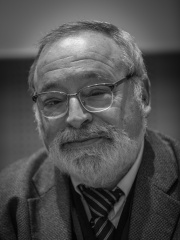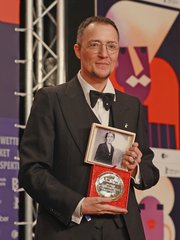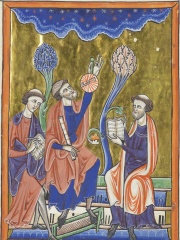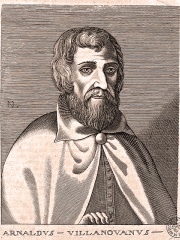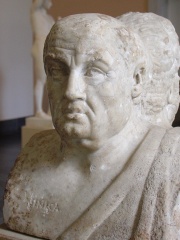
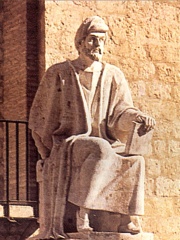

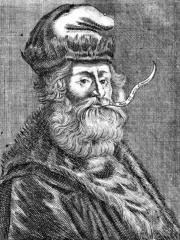
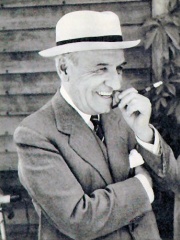
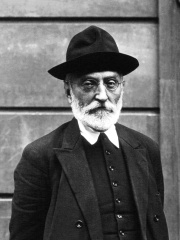
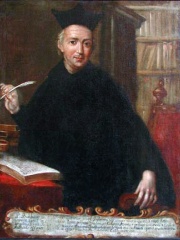
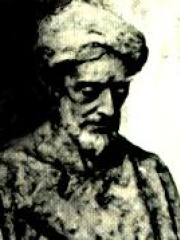
The Most Famous
PHILOSOPHERS from Spain
This page contains a list of the greatest Spanish Philosophers. The pantheon dataset contains 1,267 Philosophers, 36 of which were born in Spain. This makes Spain the birth place of the 10th most number of Philosophers behind India, and China.
Top 10
The following people are considered by Pantheon to be the top 10 most legendary Spanish Philosophers of all time. This list of famous Spanish Philosophers is sorted by HPI (Historical Popularity Index), a metric that aggregates information on a biography's online popularity. Visit the rankings page to view the entire list of Spanish Philosophers.

1. Seneca the Younger (4 BC - 65)
With an HPI of 86.81, Seneca the Younger is the most famous Spanish Philosopher. His biography has been translated into 97 different languages on wikipedia.
Lucius Annaeus Seneca the Younger ( SEN-ik-ə; c. 4 BC – AD 65), usually known mononymously as Seneca, was a Stoic philosopher of Ancient Rome, a statesman, a dramatist, and in one work, a satirist, from the post-Augustan age of Latin literature. Seneca was born in Colonia Patricia Corduba in Hispania, and was trained in rhetoric and philosophy in Rome. His father was Seneca the Elder, his elder brother was Lucius Junius Gallio Annaeanus, and his nephew was the poet Lucan. In AD 41, Seneca was exiled to the island of Corsica under emperor Claudius, but was allowed to return in 49 to become a tutor to Nero. When Nero became emperor in 54, Seneca became his advisor and, together with the praetorian prefect Sextus Afranius Burrus, provided competent government for the first five years of Nero's reign. Seneca's influence over Nero declined with time, and in 65 Seneca was executed by forced suicide for alleged complicity in the Pisonian conspiracy to assassinate Nero, of which he may have been innocent, although there is still no consensus agreement. His stoic and calm suicide has become the subject of numerous paintings. As a writer, Seneca is known for his philosophical works, and for his plays, which are all tragedies. His prose works include 12 essays and 124 letters dealing with moral issues. These writings constitute one of the most important bodies of primary material for ancient Stoicism. As a tragedian, he is best known for plays such as his Medea, Thyestes, and Phaedra. Seneca had an immense influence on later generations—during the Renaissance he was "a sage admired and venerated as an oracle of moral, even of Christian edification; a master of literary style and a model [for] dramatic art."

2. Averroes (1126 - 1198)
With an HPI of 86.05, Averroes is the 2nd most famous Spanish Philosopher. His biography has been translated into 109 different languages.
Ibn Rushd (14 April 1126 – 11 December 1198), Latinized as Averroes, was an Andalusian polymath and jurist who was proficient in a variety of intellectual fields, including philosophy, theology, medicine, astronomy, physics, psychology, mathematics, neurology, Islamic jurisprudence and law, and linguistics. The author of more than 100 books and treatises, his philosophical works include numerous commentaries on Aristotle, for which he was known in the Western world as "The Commentator" and "Father of Rationalism". Averroes was a strong proponent of Aristotelianism; he attempted to restore what he considered the original teachings of Aristotle and opposed the Neoplatonist tendencies of earlier Muslim thinkers, such as al-Farabi and Avicenna. He also defended the pursuit of philosophy against criticism by Ash'ari theologians such as Al-Ghazali. Averroes argued that philosophy was permissible in Islam and even compulsory among certain elites. He also argued scriptural text should be interpreted allegorically if it appeared to contradict conclusions reached by reason and philosophy. In Islamic jurisprudence, he wrote the Bidāyat al-Mujtahid on the differences between Islamic schools of law and the principles that caused their differences. In medicine, he proposed a new theory of stroke, described the signs and symptoms of Parkinson's disease for the first time, and might have been the first to identify the retina as the part of the eye responsible for sensing light. His medical book Al-Kulliyat fi al-Tibb, translated into Latin and known as the Colliget, became a textbook in Europe for centuries. His legacy in the Islamic world was modest for geographical and intellectual reasons. In the West, Averroes was known for his extensive commentaries on Aristotle, many of which were translated into Latin and Hebrew. The translations of his work reignited Western European interest in Aristotle and Greek thinkers, an area of study that had been widely abandoned after the fall of the Western Roman Empire. His thoughts generated controversies in Latin Christendom and triggered a philosophical movement called Averroism based on his writings. His unity of the intellect thesis, proposing that all humans share the same intellect, became one of the best-known and most controversial Averroist doctrines in the West. His works were condemned by the Catholic Church in 1270 and 1277. Although weakened by condemnations and sustained critique from Thomas Aquinas, Latin Averroism continued to attract followers up to the sixteenth century.

3. Ibn Arabi (1165 - 1240)
With an HPI of 80.85, Ibn Arabi is the 3rd most famous Spanish Philosopher. His biography has been translated into 72 different languages.
Ibn Arabi (July 1165–November 1240) was an Andalusian Arab Sunni scholar, Sufi mystic, poet, and philosopher, who exercised notable influence within Islamic thought. Of the 850 works attributed to him, about 700 are considered authentic, and more than 400 are extant. His cosmological teachings became a dominant intellectual framework in many regions of the Muslim world. His traditional title was Muḥyiddīn (Arabic: محيي الدين; The Reviver of Religion). After his death, practitioners of Sufism began referring to him by the honorific title Shaykh al-Akbar (Arabic: الشيخ الأكبر The Greatest Shaykh), from which the name Akbarism is derived. Ibn ʿArabī is considered a saint by some scholars and Muslim communities. Ibn 'Arabi is known for being the first person to explicitly delineate the concept of "wahdat al-wujud" ("Unity of Being"), a monist doctrine that claimed that all things in the universe are manifestations of a singular "reality". Ibn 'Arabi equated this "reality" with the entity he described as "the Absolute Being" ("al-wujud al-Mutlaq").

4. Ramon Llull (1232 - 1316)
With an HPI of 77.38, Ramon Llull is the 4th most famous Spanish Philosopher. His biography has been translated into 60 different languages.
Ramon Llull (; Catalan: [rəˈmoɲ ˈʎuʎ]; c. 1232 – 1316), sometimes anglicized as Raymond Lully, was a Mallorcan Catholic philosopher, theologian, poet, missionary, apologist and former knight. He invented a philosophical system known as the Art, conceived as a type of universal logic to prove the truth of Christian doctrine to interlocutors of all faiths and nationalities. The Art consists of a set of general principles and combinatorial operations. It is illustrated with diagrams. A prolific writer, he is also known for his literary works written in Catalan, which he composed to make his Art accessible to a wider audience. In addition to Catalan and Latin, he also probably wrote in Arabic (although no texts in Arabic survive). His books were translated into Occitan, French, and Castilian during his lifetime. Although his work did not enjoy huge success during his lifetime, he has had a rich and continuing reception. In the early modern period his name became associated with alchemical works. More recently he has been recognized as a precursor of the modern field of social choice theory, 450 years before Borda and Condorcet's investigations reopened the field. His ideas also prefigured the development of computation theory. Venerated as a saintly figure in the Catholic Church, he was beatified by Pope Pius IX in 1847. He was a member of the Third Order of Saint Francis.
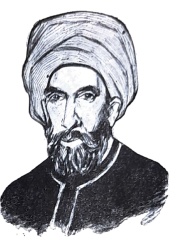
5. Ibn Tufail (1110 - 1185)
With an HPI of 75.54, Ibn Tufail is the 5th most famous Spanish Philosopher. His biography has been translated into 46 different languages.
Ibn Ṭufayl (c. 1105 – 1185) was an Arab Andalusian Muslim polymath: a writer, Islamic philosopher, Islamic theologian, physician, astronomer, and vizier. As a philosopher and novelist, he is most famous for writing the first philosophical novel, Hayy ibn Yaqdhan, considered a major work of Arabic literature emerging from Al-Andalus. As a physician, he was an early supporter of dissection and autopsy, which was expressed in his novel.

6. José Ortega y Gasset (1883 - 1955)
With an HPI of 74.71, José Ortega y Gasset is the 6th most famous Spanish Philosopher. His biography has been translated into 57 different languages.
José Ortega y Gasset ( or-TAY-gə, Spanish: [xoˈse oɾˈteɣa j ɣaˈset]; 9 May 1883 – 18 October 1955) was a Spanish philosopher and essayist. He worked during the first half of the 20th century while Spain oscillated between monarchy, republicanism and dictatorship. His philosophy has been characterized as a "philosophy of life" that "comprised a long-hidden beginning in a pragmatist metaphysics inspired by William James and with a general method from a realist phenomenology imitating Edmund Husserl, which served both his proto-existentialism (prior to Martin Heidegger's) and his realist historicism, which has been compared to both Wilhelm Dilthey and Benedetto Croce."

7. Miguel de Unamuno (1864 - 1936)
With an HPI of 73.57, Miguel de Unamuno is the 7th most famous Spanish Philosopher. His biography has been translated into 61 different languages.
Miguel de Unamuno y Jugo (; Spanish: [miˈɣ̞el de̞ unaˈmuno i ˈxuɣ̞o]; 29 September 1864 – 31 December 1936) was a Spanish essayist, novelist, poet, playwright, philosopher and academic. His major philosophical essay was The Tragic Sense of Life (1912), and his most famous novels were Abel Sánchez: The History of a Passion (1917), a modern exploration of the Cain and Abel story, and Mist (1914), which The Literary Encyclopedia calls "the most acclaimed Spanish Modernist novel".

8. Baltasar Gracián (1601 - 1658)
With an HPI of 73.52, Baltasar Gracián is the 8th most famous Spanish Philosopher. His biography has been translated into 41 different languages.
Baltasar Gracián y Morales (Spanish: [baltaˈsaɾ ɣɾaˈθjan]; 8 January 1601 – 6 December 1658), better known as Baltasar Gracián, was a Spanish Jesuit priest and Baroque prose writer and philosopher. He was born in Belmonte, near Calatayud (Aragón). His writings were lauded by Schopenhauer and Nietzsche. He is best known for his book The Art of Worldly Wisdom (1647), but his novel El Criticón (1651-57) is considered his greatest work.

9. Solomon ibn Gabirol (1021 - 1058)
With an HPI of 73.35, Solomon ibn Gabirol is the 9th most famous Spanish Philosopher. His biography has been translated into 46 different languages.
Solomon ibn Gabirol or Solomon ben Judah (Hebrew: ר׳ שְׁלֹמֹה בֶּן יְהוּדָה אִבְּן גָּבִּירוֹל, romanized: Šəlomo ben Yəhūdā ʾībən Gābīrōl, pronounced [ʃ(e)loˈmo ben jehuˈda ʔibn ɡabiˈʁol]; Arabic: أبو أيوب سليمان بن يحيى بن جبيرول, romanized: ’Abū ’Ayyūb Sulaymān bin Yaḥyá bin Jabīrūl, pronounced [ˈʔæbuː ʔæjˈjuːb sʊlæjˈmæːn bɪn ˈjæħjæː bɪn dʒæbiːˈruːl]) was an 11th-century Jewish poet and philosopher in the neoplatonic tradition in Al-Andalus. He published over a hundred poems, as well as works of Hebrew Biblical exegesis, philosophy, ethics, and satire. One source credits ibn Gabirol with creating a golem, possibly female, for household chores. In the 19th century, scholars discovered that medieval translators had Latinized ibn Gabirol's name to Avicebron or Avencebrol; his work on Jewish neoplatonic philosophy had become highly regarded in Islamic and Christian philosophical circles but attributed to only his Latinized name during the intervening years. Ibn Gabirol is well known in the history of philosophy for the doctrine that all things, including souls and intellects, are composed of matter and form ("Universal Hylomorphism") and for his emphasis on divine will.
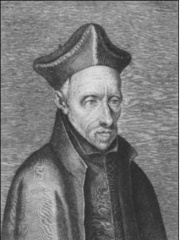
10. Francisco Suárez (1548 - 1617)
With an HPI of 73.14, Francisco Suárez is the 10th most famous Spanish Philosopher. His biography has been translated into 46 different languages.
Francisco Suárez (; 5 January 1548 – 25 September 1617) was a Spanish Jesuit priest, philosopher and theologian, one of the leading figures of the School of Salamanca movement. His work is considered a turning point in the history of second scholasticism, marking the transition from its Renaissance to its Baroque phases. According to Christopher Shields and Daniel Schwartz, "figures as distinct from one another in place, time, and philosophical orientation as Leibniz, Grotius, Pufendorf, Schopenhauer and Heidegger, all found reason to cite him as a source of inspiration and influence."
People
Pantheon has 36 people classified as Spanish philosophers born between 4 BC and 1970. Of these 36, 2 (5.56%) of them are still alive today. The most famous living Spanish philosophers include Fernando Savater, and Paul B. Preciado. The most famous deceased Spanish philosophers include Seneca the Younger, Averroes, and Ibn Arabi. As of April 2024, 1 new Spanish philosophers have been added to Pantheon including Paul B. Preciado.
Living Spanish Philosophers
Go to all RankingsDeceased Spanish Philosophers
Go to all RankingsSeneca the Younger
4 BC - 65
HPI: 86.81
Averroes
1126 - 1198
HPI: 86.05
Ibn Arabi
1165 - 1240
HPI: 80.85
Ramon Llull
1232 - 1316
HPI: 77.38
Ibn Tufail
1110 - 1185
HPI: 75.54
José Ortega y Gasset
1883 - 1955
HPI: 74.71
Miguel de Unamuno
1864 - 1936
HPI: 73.57
Baltasar Gracián
1601 - 1658
HPI: 73.52
Solomon ibn Gabirol
1021 - 1058
HPI: 73.35
Francisco Suárez
1548 - 1617
HPI: 73.14
Abraham ibn Ezra
1089 - 1167
HPI: 71.20
Arnaldus de Villa Nova
1240 - 1311
HPI: 70.69
Newly Added Spanish Philosophers (2025)
Go to all RankingsOverlapping Lives
Which Philosophers were alive at the same time? This visualization shows the lifespans of the 8 most globally memorable Philosophers since 1700.

